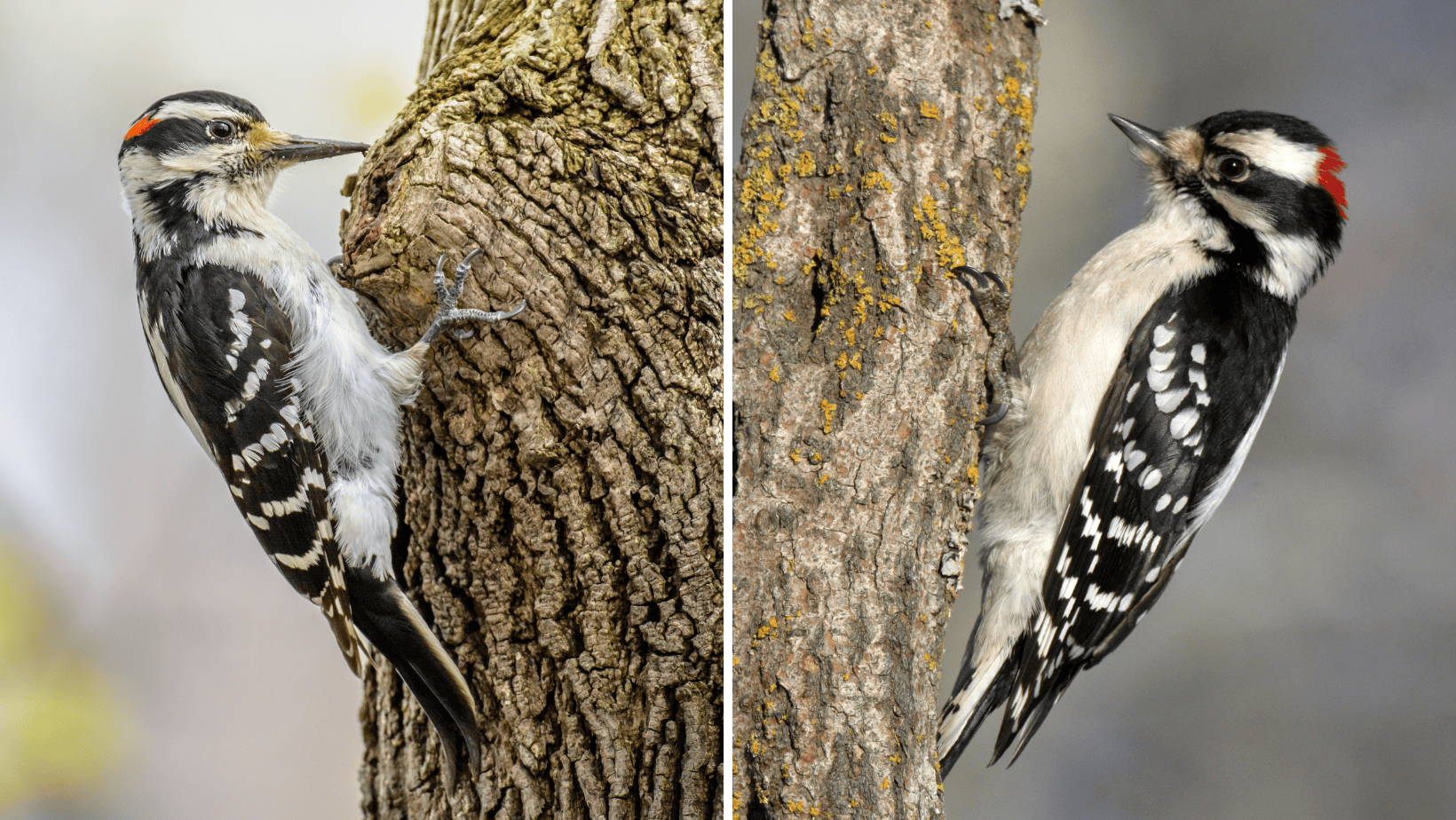Wintering Woodpeckers: A guide to identifying two look-alike birds

The hairy woodpecker, left, and downy woodpecker, right, call Muddy Creek Preserve home. Learn how to tell the difference between these look-alikes!
By Amanda Stallman, Education Coordinator
Approaching Muddy Creek Preserve, you can see the overarching oak canopy swaying in the breeze. Once the understory surrounds you, bright flashes of white and black tufts may soar by. Who are these avian friends flying about? The birds I am describing are often mistaken for one another, but upon closer look, you can determine the difference. These look-alike guests are none other than the hairy woodpecker and downy woodpecker.
These soaring friends are year-round residents of Iowa, specifically within the snags at Muddy Creek. Snags are dead or dying trees left standing on the landscape to provide habitat for wildlife. Bur Oak Land Trust leaves these rotting towers up to promote biodiversity on the landscape. Snags attract decomposers like slugs, ants and fungus to break down the wood! This is a great buffet of different insects for many bird species. Not only that, but as the birds tirelessly peck away at the bark, they also contribute to the ecosystem by creating holes for other cavity-nesting birds and small mammals.
The plentiful food source is part of the reason both these birds stay all year long. Many migratory birds travel south to find food such as berries or flying insects. Migratory songbirds have different anatomy in comparison to the woodpecker twins. Songbirds have a lighter bone structure built to echo their calls better and are unable to smack their beak against hard surfaces. Woodpeckers can crack open cold bark with their bill by having a more robust skull structure. In addition to a thicker skull, they also have a built-in bone that absorbs the shock from their bill striking trees all day. This genetic trait aids in the ability to find insects under bark, even in the bitterest of winter months.
As you start your journey into birding, there are many other methods to help identify birds of Iowa. Sightings are one of the most common ways of identifying birds, searching for their unique colorations, spots within their feathers, or even detecting their flight pattern. Relying on sightings of the downy and hairy woodpecker can be tricky. When using sightings to find both species, I search for red feathers at the back of the bird’s head. Since both these birds have a red marking, it doesn’t necessarily help you tell them apart, but it enables you to find them! One of the only coloration differences between the two birds are the black spots on the underside of the downy woodpecker’s tail. It is not easy to see these spots as they are typically hidden by a layer of black feathers.
The main distinction between the woodpeckers is their size. The body of the hairy woodpecker is slightly larger, measuring around 9.5 inches long. In comparison, the downy woodpecker can reach up to 6.5 inches long. This can be equivalent to the size differences between a cardinal and an eastern bluebird. Another key characteristic of these birds is their bill. The hairy woodpecker’s bill is roughly the same length as its head, while the downy woodpecker’s bill is much shorter. My favorite method of identifying these birds is using their bill size!
Other methods can include growing familiar with their calls and sounds. Using their calls for identification can be a challenge, especially for these two species, as their calls are very similar in sound. The hairy woodpecker holds a sharp, short high note and descends with pitch as the call ends, while the downy woodpecker shares the same sharp note, just at a lower pitch.
With a bit of practice and patience, you will distinguish between these two species quickly. The next time you visit Muddy Creek Preserve, grab your binoculars and be on the lookout for these beautiful birds!
Beginning Birding Tips:
- Download Merlin Bird ID or eBird apps
- Join a local birding group like Iowa City Bird Club or Iowa Young Birders
- Bring a guide book with you!
- Have patience with your growing skills
- Use slow, and softer movements as you hike
- Use a bird blind for viewing!


